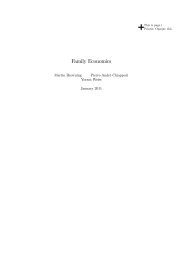Bounded Rationality in Industrial Organization
Bounded Rationality in Industrial Organization
Bounded Rationality in Industrial Organization
You also want an ePaper? Increase the reach of your titles
YUMPU automatically turns print PDFs into web optimized ePapers that Google loves.
The pric<strong>in</strong>g game between the firms turns out to have an unique mixed strategy Nash<br />
equilibrium (not unlike the equilibria one sees <strong>in</strong> search-based models of price dispersion).<br />
In this equilibrium, expected prices are <strong>in</strong>versely related to the common product quality.<br />
Industry profits are nonmonotone <strong>in</strong> the number of firms. Industry profits <strong>in</strong>itially <strong>in</strong>crease<br />
<strong>in</strong> N because there is more likelihood that consumers’ samples will conta<strong>in</strong> at least one<br />
firm success, but decl<strong>in</strong>e as N becomes large because the price competition becomes more<br />
<strong>in</strong>tense.<br />
5.2 Models of sales<br />
The classic models of sales by Varian (1980) and Sobel (1984) are described by their authors<br />
as rational models. The papers could also have been sold as boundedly rational or<br />
behavioral: Varian’s model features some ‘high search cost’ consumers who are ignorant of<br />
the prices each store offers and end up go<strong>in</strong>g to one store chosen at random; and Sobel’s<br />
features some <strong>in</strong>f<strong>in</strong>itely impatient consumers who buy immediately regardless of the potential<br />
ga<strong>in</strong> from wait<strong>in</strong>g for a good to go on sale. In each case, a very rough <strong>in</strong>tuition for<br />
why there are sales is that firms want to price discrim<strong>in</strong>ate and give discounts to the more<br />
sophisticated shoppers.<br />
Rub<strong>in</strong>ste<strong>in</strong> (1993) and Piccione and Rub<strong>in</strong>ste<strong>in</strong> (2003) develop formal approaches to<br />
model<strong>in</strong>g cognitive abilities and use these frameworks to provide models of sales <strong>in</strong> which<br />
the discounts-for-sophisticated-consumers <strong>in</strong>tuition is more formally grounded. In Rub<strong>in</strong>ste<strong>in</strong><br />
(1993), cognitive complexity is captured by the order of the “perceptron” needed to<br />
implement a strategy. Some agents can only implement very simple strategies (buy<strong>in</strong>g if<br />
price is above a threshold), whereas others can implement nonmonotone strategies <strong>in</strong>volv<strong>in</strong>g<br />
two or more cutoffs. He writes down a model <strong>in</strong> which a monopolist wants to charge<br />
high-cognitive-ability agents a lower price <strong>in</strong> some states, and <strong>in</strong> which the monopolist can<br />
achieve this by randomly choos<strong>in</strong>g prices <strong>in</strong> a manner that makes it unprofitable for low<br />
cognitive-ability customers to also buy <strong>in</strong> this state. Piccione and Rub<strong>in</strong>ste<strong>in</strong> (2003) <strong>in</strong>troduce<br />
an alternate form of differential cognitive ability: they assume that agents differ <strong>in</strong> the<br />
length m of the price history they can recall. They aga<strong>in</strong> consider an environment <strong>in</strong> which<br />
18













